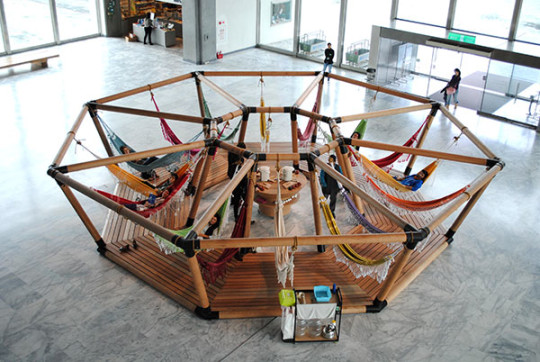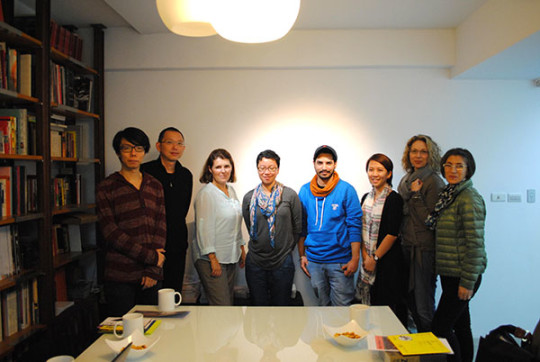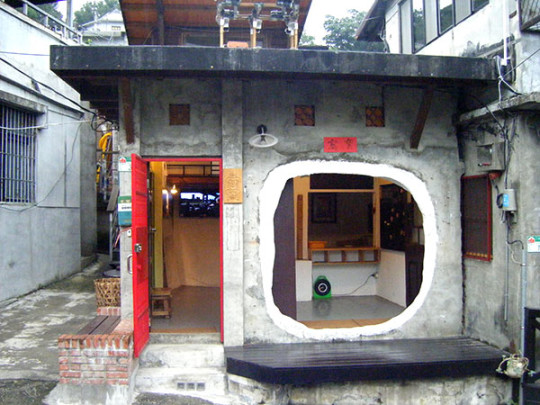by Stephanie Xatart and Samantha Segar
The much anticipated study trip of the Asian Art Histories 2014/15 Master’s Programme took us to Taipei, Taiwan. The trip was from 9 Dec to 13 Dec 2014.
There we were delighted to explore many facets of Taipei’s vibrant and edgy art scene. The first stage of our cultural journey took us to the Taipei Biennale where we attempted to come to terms with relational aesthetics. Curated by the man behind the theory himself, Nicolas Bourriaud, the Biennale sparked a number of discussions throughout our stay but also offered a great playground, or a phenomenological approach to art through experimentation. We complied with the many exhibition invitations and partook of the communal tea drinking / hammock lounging (Formosa Decelarator by art collective OPAVIVARA!) and a most memorable session amidst a spectacular accumulation of coloured hanks of wool (Golden Ghost [Reality Called, So I Woke Up] by Surasi Kusolwong). Wittily, the artist had hidden golden necklaces within the installation, which proved to be, unsurprisingly, an excellent incentive to literally dig in. We also marvelled at Faciathérapie (Mina Hebbaz) by Camille Henrot, longing for a long back massage.
Another visit took us to the Museum of Contemporary Art. There we toured the 2nd Pulima Art Award exhibition and found ourselves riveted by George Nuku’s Bottled Ocean 2114. Pulima’s focus is the discussion of cultural and environmental issues via the production of artists with Austronesian heritage. On the way back our fabulously inquisitive guide asked for a definition of contemporary art, sadly we were not able to provide him with one definite answer, although the exercise kept us busy on our bus rides throughout the stay.
Literally meaning “city in northern Taiwan,” Taipei is the cultural, political and economic capital of ROC. At first glance, the city has a confused look that reflects its history marked by six colonial occupations. Indeed, there has been no coherent architectural development especially at the beginning of the Kuomintang. Later, an attempt to set up a mode of urban planning with a typical grid did not succeed. One commentator reasoned, “People have built what they wanted to build, what they needed.”
This bottom up development is somewhat reflected in the contemporary art scene. While the government now supports local artists and international art initiatives (Venice Biennale, Taipei Biennale), Taiwanese artist groups have run their own alternative spaces since the 1980s. IT Park, one of the longest-running alternative art spaces in the region, was one of our stops. We also visited VT Artsalon where its current director Yao Jui-Chung welcomed us. Yao was one of the eight founding artists of this well-known art incubator. Another of the founders Wu Dar-Kuen is currently curator of the Kuandu Museum of Fine Arts at the National Taipei University of the Arts, and by a sheer stroke of luck we were able to catch the Kuandu Biennale.
Entitled Recognition System, this small biennale featured ten pairs of artists and curators from different countries in Asia. It employed various strategies to engage the viewers with participatory installations as well as stimulating the somatosensory system (also recently explored back home with Sensorium 360° at the Singapore Art Museum). We were particularly wowed at Relative Perception N°1[0°–N°] by Chang Yung-Ta and Ruins: Re-Deconstruction of Li Gang’s Ink by Li Gang, but nothing stunned us more that the exceptional shooting skills of Dr. Wulan Dirgantoro in Kwan Sheung-Chi’s participatory installation Night Market. By way of extending the experience, fermented tofu and bubble tea prevailed that evening as we regrouped at the Ningxia Night Market.
Arguably the golden moments of the study trip were our visits to cultural centres and artist villages. Taipei is located in a basin surrounded by hills, on the slope of one of these sits Treasure Hill Artist Village. Formerly private homes, these charming hillside spaces now offer an artist-in-residence programme and welcome art practitioners from around the globe. We particularly enjoyed hiking up and down narrow outdoor stairs, peeking in and out of studios, and admiring the local vegetable gardens. Our last morning found us at Bamboo Curtain Studio where we were greeted by Ping-Chi Hung and met with Margaret Shiu, the rather impressive director and founder. Some of us were so inspired that we decided next we should go for an MA in Fine Arts just so we can apply to their residency programme!
Calling the study strip a highlight of the programme is no euphemism. Sadly, we still haven’t fully figured out relational aesthetics and more particularly how it applies to our field…or does it?
This article was written by Stephanie Xatart and Samantha Segar, currently students of the MA Asian Art Histories Programme.



![Surasi Kusolwong, Golden Ghost [Reality Called, So I Woke Up], 2014](http://www.asianarthistories.com/site/wp-content/uploads/2015/06/taipei2-540x362.jpg)

![Chang Yung-Ta, Relative Perception N.1[0-N], 2014](http://www.asianarthistories.com/site/wp-content/uploads/2015/06/taipei4-405x540.jpg)
